Children of the Amazon
Air Date: Week of August 24, 2007
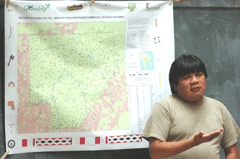
Chief Almir Surui explains one of the cultural maps made by members of his community with the help of the Amazon Conservation Team. (Courtesy of Amazon Conservation Team)
Filmmaker Denise Zmekhol talks with Bruce Gellerman about the Surui people of the Amazon, the subjects of her new PBS film “Children of the Amazon.”
Transcript
GELLERMAN: It’s Living on Earth. I’m Bruce Gellerman.
[BIRDS IN FOREST]
GELLERMAN: This is the sound of the Amazon rainforest. It’s one of the richest places on the planet for plants and wildlife and home to scores of remote indigenous tribes. The forest is also one of the most important places in the world for regulating carbon dioxide in the atmosphere.
[CHAIN SAWS AND TREE FALLS]
GELLERMAN: This too is the sound of the Amazon. Chainsaws and bulldozers have been carving away at the rainforest for decades clearing land for highways, cattle ranches and soybean plantations. It’s estimated that nearly 20 percent of the Amazon has been cleared, including an area almost the size of New Hampshire just last year.
Much of the destruction of the Amazon forest has taken place on the territory of indigenous tribes. In just a few brief years, members of many of these isolated societies were wrenched from the stone age into the space age… some driven nearly to extinction by their first contact with the outside world.
Almost 20 years ago, Denise Zmekhol traveled deep into the Amazon to photograph and document their struggles. She recently returned with a film crew to examine the changes the people of the rainforest have gone through since her first visit. Her new film is called “Children of the Amazon.”
It focuses on one tribe in particular: the Surui. Denise Zmekhol says the Surui never had contact with the outside world until the roads we built.
ZMEKHOL: The first official contact happened in 1969 when they were still living in what I call in the film “forest time.” It’s a very recent contact and I think they had to learn a lot about our society and our world in such a small time. So for thousands of years they were living in one way and just 39 years ago everything changed for them. So, yeah it’s pretty recent.
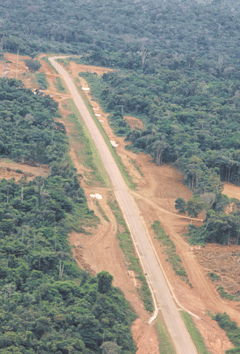
Highway BR364 was built through the heart of Surui territory. It brought an agricultural boom to Brazil but death and disease to indigenous groups. (Courtesy of Denise Zmekhol)
ZMEKHOL: Well, it’s a concept that we kind of use in the film when we interview one of the Surui girls and she mentions this term “tempo de floresta.” It was the time they were living by themselves isolated from settlers and loggers, hunting and fishing. So, that’s to me what’s forest time, when they were living in their ways.
GELLERMAN: And then things change very dramatically in 1969, the Brazilian government and the World Bank team up to build this road right through the heart of Surui territory and there’s a section in your film about that development.
[DOCUMENTARY MUSIC PORTUGUESE AND THEN ENGLISH TRANSLATION]
DOCUMENTARY: It is not enough to build roads. We must colonize for agriculture or for cattle. The land is good. There are green pastures in the forest made of milk and honey.
ZMEKHOL: That’s when I was growing up and they were building these roads in the Amazon. The military government was really thinking of the best solution for the Amazon was to develop and bring people from other parts of Brazil who had no land to farm. So they were trying to solve all kinds of problems and they thought it was a great idea at that time to do it, but they had no idea that the impact was going to be so huge and destructive.
GELLERMAN: The road brings people and settlers and the Surui are a warrior tribe but they can’t fight off these people and they certainly can’t fight off the diseases that the settlers bring.
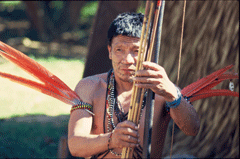
Photo of a Sururi warrior taken in 1987. (Courtesy of Denise Zmekhol)
GELLERMAN: The diseases kill off most of the elders. The culture is decimated. The oral traditions are almost lost.
ZMEKHOL: Yes, because they don’t have a written language. They don’t use writing so everything is passed on from one generation to another. So, the elders die it’s like loosing encyclopedia of traditions and customs. They really don’t have any reference, any way to keep teaching the new generations.
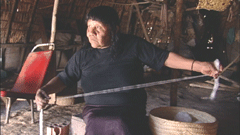
Almir’s mother was one of the few elders that survived the diseases brought by Westerners from the first contact. (Courtesy of Denise Zmekhol)
ZMEKHOL: Yes, well Chico Mendes his story is that his family came to harvest rubber I would say maybe 100 years ago. He was born in the forest and he was a rubber tapper and his father was a rubber tapper. He was part of the forest and he knew how important it was to keep all those forests standing and he got a passport and flew to the United States and did a lot of lobbying and he was heard.
[VILLAGE SOUNDS]
ZMEKHOL: In this scene he was being interviewed in his window and he was holding his son Sandino who was at that time two years old.
[CHICO MENDES SPEAKS POTUGUESE WITH ENGLISH OVER IT]
TRANSLATOR: After my trip to the United States political pressure was put on the international banks that were largely responsible for the devastation of the Amazon because of the projects they funded.
ZMEKHOL: He was talking about serious stuff and how his trip to the U.S. had really made a difference you know and had created a lot of pressure and things were changing.
[MENDES IN POTUGUESE THEN ENGLISH]
TRANSLATOR: Projects which had the false slogan of Amazonian development but were a disaster.
ZMEKHOL: And Sandino was just playing and looking at us, and making those nice sounds. So it’s a very beautiful image.
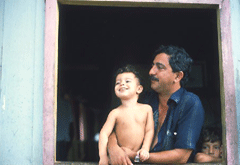
Chico Mendes and his son Sandino one month before Chico’s assassination. (Courtesy of Denise Zmekhol)
ZMEKHOL: Yeah, and it’s a very sad chapter of that story because he was fighting with big forces you know, big economic forces. He was calling attention, international attention, to the Amazon. And I think one year after he was here the financing of the paving of the road in his state was suspended. And that’s when a lot of ranchers and politicians got really mad at him. But he was very brave. You know he really felt that it was an important thing to do and he went for it.
GELLERMAN: He asked you to film his funeral. He knew he was going to die.
ZMEKHOL: Yeah, he knew and just being around him one month before his assassination you could tell that it could happen any time. It was very tense. And he had already two bodyguards following him around but it wasn’t enough to stop the murders. But the thing is it’s a landless, sorry a lawless world. It’s the last frontier, people kill each other no matter what. You know it’s so hard everything. The police are so corrupt. It’s so complicated, so complex.
GELLERMAN: Have you ever been threatened while working there?
ZMEKHOL: No, but I have felt a little uncomfortable interviewing some people. I remember one of the people that I felt the most uncomfortable was one of the ranchers in the state of Acre where Chico’s from. We knew he was part of this group of ranchers who really wanted to get rid of Chico and he was involved in Chico’s assassination. We went to do an interview with him. And we just left the interview feeling like oh my God maybe there’s a bomb under our car or someone is going to shoot us. We just felt like anything can happen you know.
GELLERMAN: You know Denise, it’s interesting. I had a recent opportunity to talk to someone who’s in your film, Almir Surui, He’s now a tribal leader. He was the first one in the tribe to go to college. When I spoke with him he was along with Vasco Van Roosmalen from the Amazon Conservation Team and I guess they were touring the United States. But when I spoke with Almir he told me how dangerous it is to live in his area.
[ALMIR SPEAKS PORTUGUESE AND VASCO TRANSLATES]
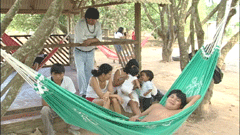
Chief Almir Surui and his family (Courtesy of Denise Zmekhol)
VAN ROOSMALEN: And here I would like to include a side note, is that they are living in a real frontier area where people truly believe that development is deforestation. But the only time Almir ever considered selling logs was when his adopted daughter hadn’t eaten in two days, hadn’t been able to drink milk. And when she was crying at home he looked at her and he says and thought to himself, “why don’t I just sell out?” And he ended up not doing it. It’s not as if these people are sitting in a very comfortable position. Their cultures are being taken away. They don’t have many economic options that are being supported.
GELLERMAN: So, Denise, what are the economic options for these people?
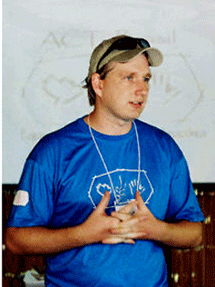
Vasco Van Roosmalen, director of the Brazil program for Amazon Conservation Team (Courtesy of Amazon Conservation Team)
GELLERMAN: And they’re using new technologies. When I spoke with Vasco he told me about the Amazon Conservation Team’s project to help map the area. They never had maps and they’re creating these not just geographic maps but cultural maps. Let’s listen to a little of that conversation.
VAN ROOSMALEN: They have so much knowledge of their territory it’s really just opening the door to them and giving them very basic tools, GPS devices. It’s just sitting them down with the right experts for a week and when they come out they become expert mappers. And I have seen indigenous mappers draw in freehand creeks onto a base map and then we’ve overlayed them just for fun with satellite pictures and they were completely correct. And you can see that as he’s drawing it he’s back in his canoe going right and left and right and left. It’s amazing their ability and their connection to the land.

Chief Almir Surui explains one of the cultural maps made by members of his community with the help of the Amazon Conservation Team. (Courtesy of Amazon Conservation Team)
ZMEKHOL: Oh, that’s beautiful you know it’s exactly how I you know, we can’t disconnect them from their land. It’s a vital part of their everyday life. There is no separation between the tradition, the harvesting, the hunting. Everything is so integrated to the forest.
GELLERMAN: But do you think making a map will help these people preserve their culture and defend their territory?
ZMEKHOL: Well, I hope so. They have to try anything to protect their land and their territory because it’s really a hard battle there. It’s like the last frontier, it’s the same feeling, it’s like the Wild West of Brazil. It’s completely out of control.
GELLERMAN: Well, when I talked with Almir he didn’t sound like he was ever going to give up on this cause.
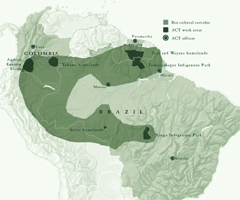
Map of Brazil which shows the extent of indigenous lands and the location of the Surui homelands. (Courtesy of Amazon Conservation Team)
GELLERMAN: Well, he says he’s not a hero but he told me he’s not backing down.
[VASCO TRANSLATES FOR ALMIR]
TRANSLATOR: I haven’t sold out because I want the future of my people and of humanity and of the entire world. If we give up our struggle what will be the future of the world? What will be the future of the Surui people, what will be the future of the American people, or the rest of the world? I feel sorry for those who threaten me when I’m working to protect the forest because I’m working to protect their future as well.
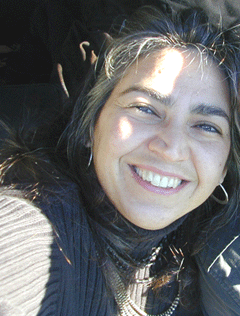
Photographer and documentary filmmaker Denise Zmekhol (Courtesy of Denise Zmekhol)
GELLERMAN: What do you want to happen as a result of your film?
ZMEKHOL: Oh, I’d just, I’d like to contribute to this change in the consciousness. And I think it’s a moment that we all have to think that we’re living on the same planet and the planet is at high risk. I think it’s all so much related that we can’t just give our backs and think “wow, this is not going to affect me.” It is already affecting us all.
GELLERMAN: Denise, thank you very much.
ZMEKHOL: Oh, thank so much. It was very nice talking to you.
GELLERMAN: Brazilian filmmaker Denise Zmekhol’s documentary “Children of the Amazon” will be shown next year on PBS. You can find a link to the director’s Web site at LOE dot org.
[MUSIC: Milton Nascimento “Me Deixa Em Paz,” Club Da Esquina 2 (Polydor 1972)]
Links
Living on Earth wants to hear from you!
Living on Earth
62 Calef Highway, Suite 212
Lee, NH 03861
Telephone: 617-287-4121
E-mail: comments@loe.org
Newsletter [Click here]
Donate to Living on Earth!
Living on Earth is an independent media program and relies entirely on contributions from listeners and institutions supporting public service. Please donate now to preserve an independent environmental voice.
NewsletterLiving on Earth offers a weekly delivery of the show's rundown to your mailbox. Sign up for our newsletter today!
 Sailors For The Sea: Be the change you want to sea.
Sailors For The Sea: Be the change you want to sea.
 The Grantham Foundation for the Protection of the Environment: Committed to protecting and improving the health of the global environment.
The Grantham Foundation for the Protection of the Environment: Committed to protecting and improving the health of the global environment.
 Contribute to Living on Earth and receive, as our gift to you, an archival print of one of Mark Seth Lender's extraordinary wildlife photographs. Follow the link to see Mark's current collection of photographs.
Contribute to Living on Earth and receive, as our gift to you, an archival print of one of Mark Seth Lender's extraordinary wildlife photographs. Follow the link to see Mark's current collection of photographs.
 Buy a signed copy of Mark Seth Lender's book Smeagull the Seagull & support Living on Earth
Buy a signed copy of Mark Seth Lender's book Smeagull the Seagull & support Living on Earth

